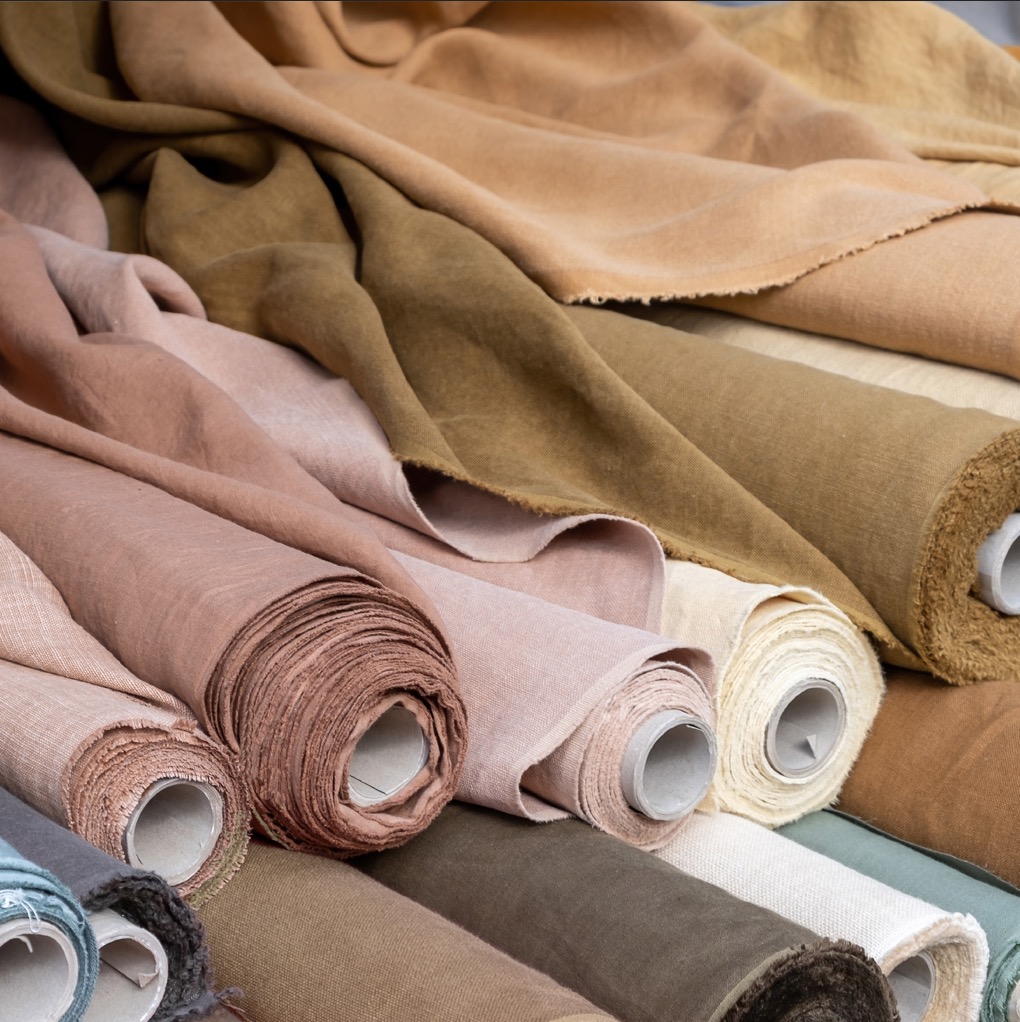
Improving your Fabric Knowledge
There is so much to learn about fabrics it is hard to know where to start! When I was studying Fashion Design in college it was one of the disciplines we were taught. There has been so much development in fabrics and technology over the years it is important to keep up to date. There is a huge difference when you are looking at individual fabrics rolls for small production runs versus sourcing fabrics for bulk production.
If you’re looking to develop your fabric knowledge, there are a few different ways you can go about it. Firstly, take a look at the items in your wardrobe and look at the care labels to see what your t-shirts are made of? They can be 100% cotton / 100% polyester / 100% viscose or a mix of Polyester and cotton or may have spandex / elastane for stretch and recovery. In addition your t-shirts may ‘feel ‘ different to touch – they may feel lighter in weight ( ‘thinner’ ) or heavier in weight ( ‘thicker’). This does not mean one is better quality than the other – it is just the weights of the fabrics are different.
The ‘standard’ weight for a single jersey cotton t-shirt is 180 gsm (grammar per square meter), this can be increased for winter to 200gsm or decreased to 160gsm depending on the look or silhouette the buyer want to follow.
You can expand your research to learn about the different types of fabrics that are available, how to source fabrics and what to look for when choosing fabrics. Additionally, it is important to learn how to identify and check for quality fabric when selecting fabrics. By understanding each of the individual fabric properties you’ll be able to make better decisions when it comes to selecting fabrics for your ranges.
Let’s dive in…
Types of fabrics available
There are so many different types of fabrics available on the market today. It can be overwhelming to understand the differences between them and what is the best options for your style.This means considering your customer profile, the season you are buying for,your available budget and the complexity of the design. In this post, we’ll take a closer look at some of the most common fabrics – cotton, wool, silk, and synthetic fabrics and explain simply what their unique properties and characteristics are.
- Cotton is a natural fabric that is breathable and absorbent. It is usually used for making shirts, pants, and other garments. Cotton is a versatile fabric that can be used for many different garments.
- Wool is a natural fabric that is warm and insulating. It is often used for making sweaters, coats, and other winter clothing. Wool is a great choice for garments that need to be warm and cozy.
- Silk is a natural fabric that is soft and luxurious. It is often used for making dresses, blouses, and other formalwear. Silk is a beautiful fabric that can add a touch of luxury to any garment.
- Synthetic fabrics are made from man-made materials such as polyester, nylon, and acrylic. They are often used for making activewear, outerwear, and other garments that need to be durable. Synthetic fabrics are a great choice for garments that need to be strong and long-lasting.
How to choose the right fabric for a project
There are three main types of fabric: natural fibers, synthetic fibers, and blends. Natural fibers include cotton, linen, wool, and silk. Synthetic fibers include polyester, nylon, and acrylic. Blends are fabrics that are made from a combination of natural and synthetic fibers, like cotton/polyester or wool/acrylic.
Each type of fabric has different properties that you’ll need to take into account when selecting the right one for your garments. These properties include texture, weight, stretch, and opacity.
- Texture refers to the way the fabric feels. Smooth fabrics have a sleek surface, while rough fabrics are more textured. Soft fabrics are, well, soft to the touch, while crisp fabrics are stiffer.
- Weight is how heavy the fabric is. Lightweight fabrics are thin and airy, while heavyweight fabrics are thicker and more substantial.
- Stretch refers to how much the fabric can stretch. fabrics with no stretch don’t stretch at all, while fabrics with high stretch can stretch a lot.
- Opacity is how see-through the fabric is. Opaque fabrics can’t be seen through at all, while sheer fabrics are very transparent.
When sourcing fabrics, you’ll want to keep all of these properties in mind to make sure you’re choosing the right one for your garment. In addition to this., you’ll want to check the fabric for any defects, check the fabric for a tight weave to ensure no gaps, and test the fabric for colorfastness and shrinkage.
What to look for when sourcing fabrics
When it comes to sourcing fabrics, there are a few key things you should keep in mind.
Always check the fabric content label to see what the fabric is made of. This will give you an idea of how the fabric will behave and how durable it is. Next, examine the fabric itself to look for any flaws or imperfections. Finally, always test the fabric before you use it to make sure it meets your standards.
But what exactly should you be looking for when you check the fabric content label? And how can you tell if a fabric is flawed or imperfect? Let’s take a closer look.
- When you check the fabric content label, you should look for natural fibers like cotton, linen, or wool. These fibers are more durable than synthetic fibers like polyester or nylon. You should also avoid fabrics that have been treated with chemicals or have a lot of synthetic dyes. These treatments can make the fabric less durable and more likely to fade.
- When you examine the fabric itself, you should look for any flaws or imperfections. These can include loose threads, uneven stitching, or spots where the fabric is damaged. If you find any of these, it’s best to avoid using that fabric.
- Always test the fabric before you use it. This will help you make sure it meets your standards. You can test the fabric by washing it, ironing it, or sewing it. If the fabric meets your standards, then you can be sure you’re getting a quality product.
All garments for sale in retail stores are subject to various testing criteria and parameters to ensure they are fit for purpose . Check out which standards apply to your region or country.Here are some of the more common ones you should be aware of especially when you have to approve build production for large quantities of products
Colour fastness in response to light, rubbing, and wetness
New and unworn fabrics will be vibrant in colour that you want to last for the lifetime of the garment. Unfortunately, colours do begin to fade with wash and wear and tear. Depending on the specific nature of the fabric , you should check out the colourfastness of each piece and how it responds to different irritants.
Colourfastness in response to light
For example, many colours will begin to fade in the light. Whether you choose a natural fibre such as cotton. Or synthetic fibres such as nylon or polyester, they all have a colour fading point. UV rays, sunlight, and the flashes from photography all have an effect, so you need to choose your fabric according to its future exposures.
When producing fabrics, manufacturers use a grading system that lets you know how quickly they’ll fade. The grades range from one to five. Fabrics with a 5 rating are robust and resistant to light, while those with a one will fade easily.
Colourfastness in response to colours transferring from one fabric to another
In the fabric industry, professionals refer to this as “Wet and dry crocking or rubbing.” For example, when you wear a dark pair of jeans featuring heavy dye, there’s a chance you’ll transfer the colour to your fabric. This can happen both when they’re dry and wet, which means you need to consider the risk of transfer when choosing fabrics for certain uses. This is really important and can be costly to your business I remember one incident when we received a customer complaint that her blue pants had left a blue dye all over her cream leather couch after sitting on it for a while !!
Using a test method called ISO-105×12:2001, manufacturers will take a standard piece of white cotton and rub it against the fabric they’re making in both wet and dry states. They’ll do this a specific number of times, then compare the amount of colour that transfers to a chart.
Again, a grading system indicates how likely it is that colour will transfer. At Grade 5, there’s a low risk and at Grade 1 there’s a high risk. Ideally, if you’re using your fabric for upholstery purposes, you should aim for grades 4 or 5.
Colourfastness due to sweating
The nature of each person’s sweat varies, meaning it can become alkaline or acidic. Similarly, pets and other areas of the environment expose fabrics to different antiperspirants that can damage their colour and design.
Again, the grades a manufacturer measures colourfastness due to sweating against vary between one and five, with five remaining the strongest and one being the worst. If you want to see a minimal colour change due to perspiration of any type, aim for fabrics of quality four or five.
How flammable the fabric is
All fabric is flammable to a degree. However, how flammable it becomes especially important in certain environments. For example, using a fabric that’s less susceptible to flames in a residential home or on an aeroplane is important, as there is a low chance of safe escape.
Childrenswear products in particular for the nightwear category for example have restriction for the fabric compositions permitted in certain regions. A specific test determines how flammable a fabric is. The NFPA 701-89 requires manufacturers to expose the fabric to fire for twelve seconds and then they measure the following effects afterwards:
- How big the flame is
- The amount of charring left afterwards
- Any remaining flaming residue
Like colourfastness, this then places the fabric’s flammable nature into a grade category. While some manufacturers may describe their fabrics as non-flammable or as having a low flame level, it’s worth bearing in mind that external factors influence this. For example, the fuel starting the flame, the presence of oxygen, and other combustible materials in the area all play a role.
While it seems as though there’s a lot to consider when understanding and selecting it is worth putting the effort to improve your fabric knowledge,. Research the different types of fabrics available, speak to your manufacturers learn how to source fabrics, and check for quality. By doing this, you’ll be able to choose the best fabrics for your needs and ensure that you’re getting high-quality garments for your business.




